Abstract
The primary aim of this study was to investigate whether individual self-reports of perceived ability to use a condom correctly correlated with the actual ability to do so. Participants in the study were 3,059 clients of a sexually transmitted disease clinic. The findings revealed that the participants' perceived self-efficacy with regard to using a condom effectively was a poor indicator of their clinically demonstrated skills using a penile model as scored on the 6-point Condom Skills Index. Condom skills, in general, were found to be at a moderate level only. Even though 89 percent of the sample were persons who said they were somewhat or very sure that they could put a condom on and take it off correctly, the sample mean score on the Condom Skills Index was only 3.6, or 60 percent correct. Perceived versus demonstrated condom skills showed poor correlations for both the relatively lower-risk group (r = .09; P < .001 and the pooled higher risk groups (r = .12; P < .001). Although men were significantly more likely than women to believe they had adequate condom skills, no significant differences were found between the clinically demonstrated condom skills of males and females. Although condom promotion has included issues of product quality and consistent use, little attention has focused on correct use. Hence, when interventions aimed at reducing risk for HIV focus on developing communication-negotiation skills regarding the consistent use of condoms, attention also should be directed toward developing skills for using condoms effectively.
Full text
PDF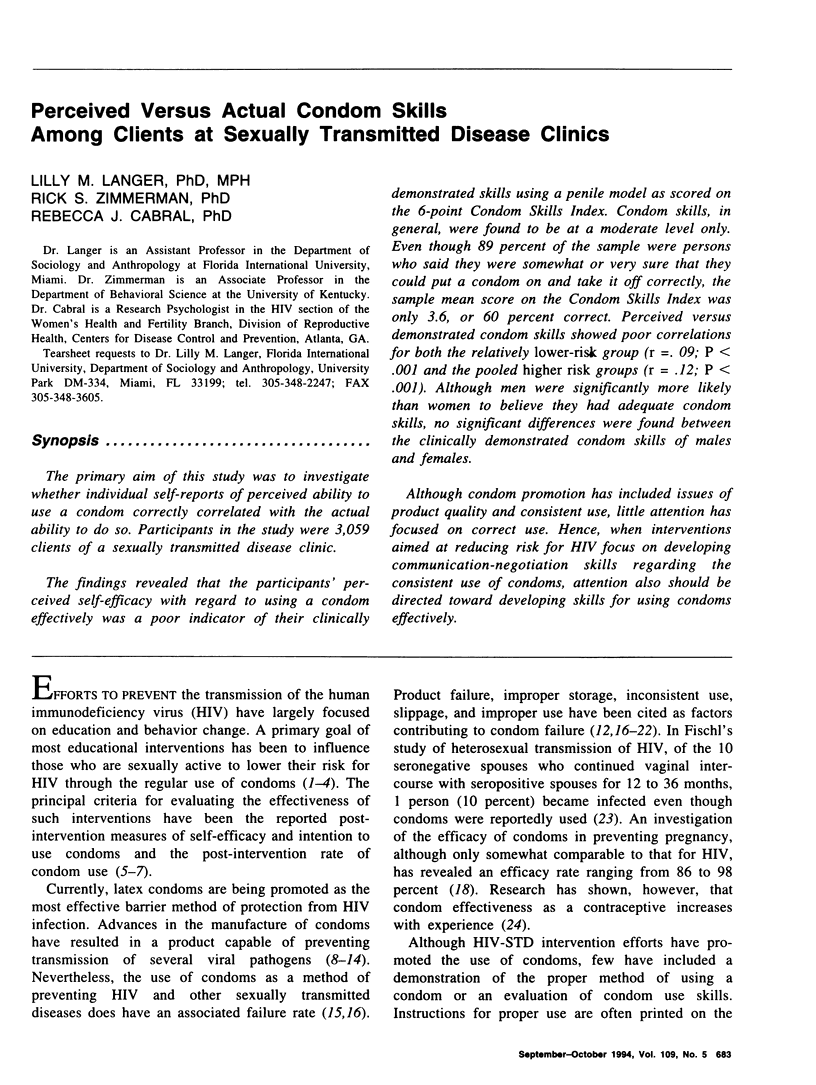
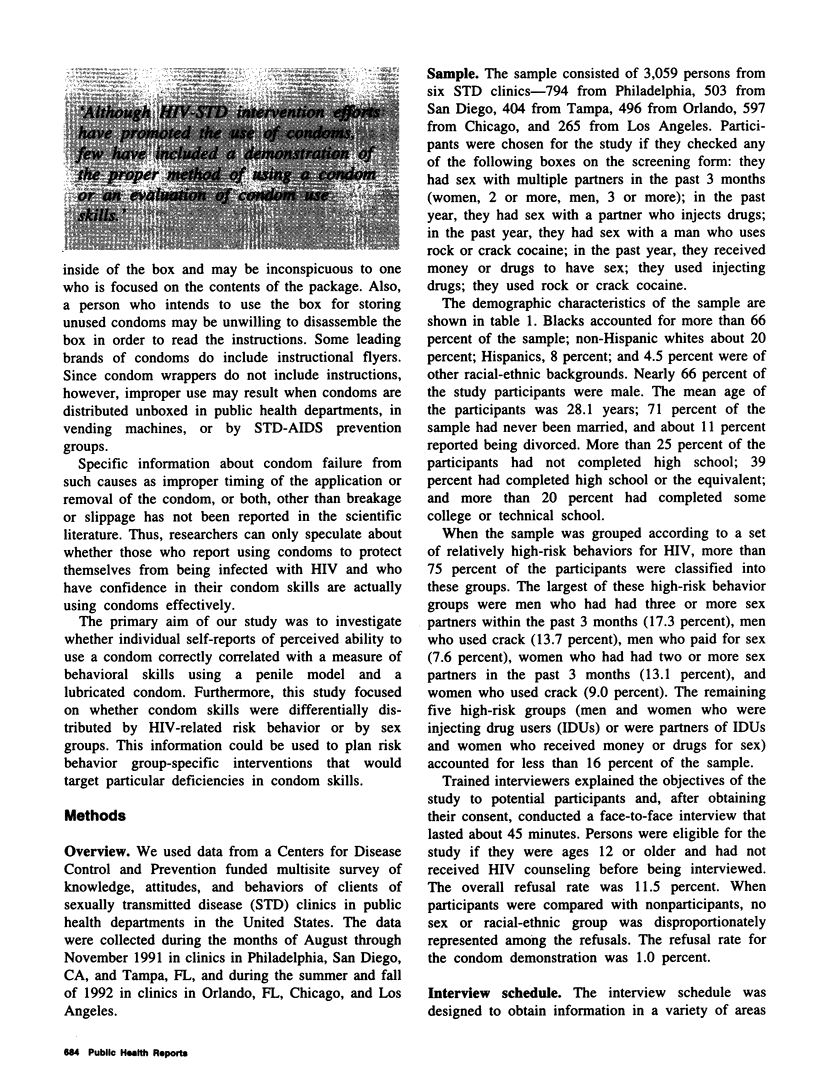
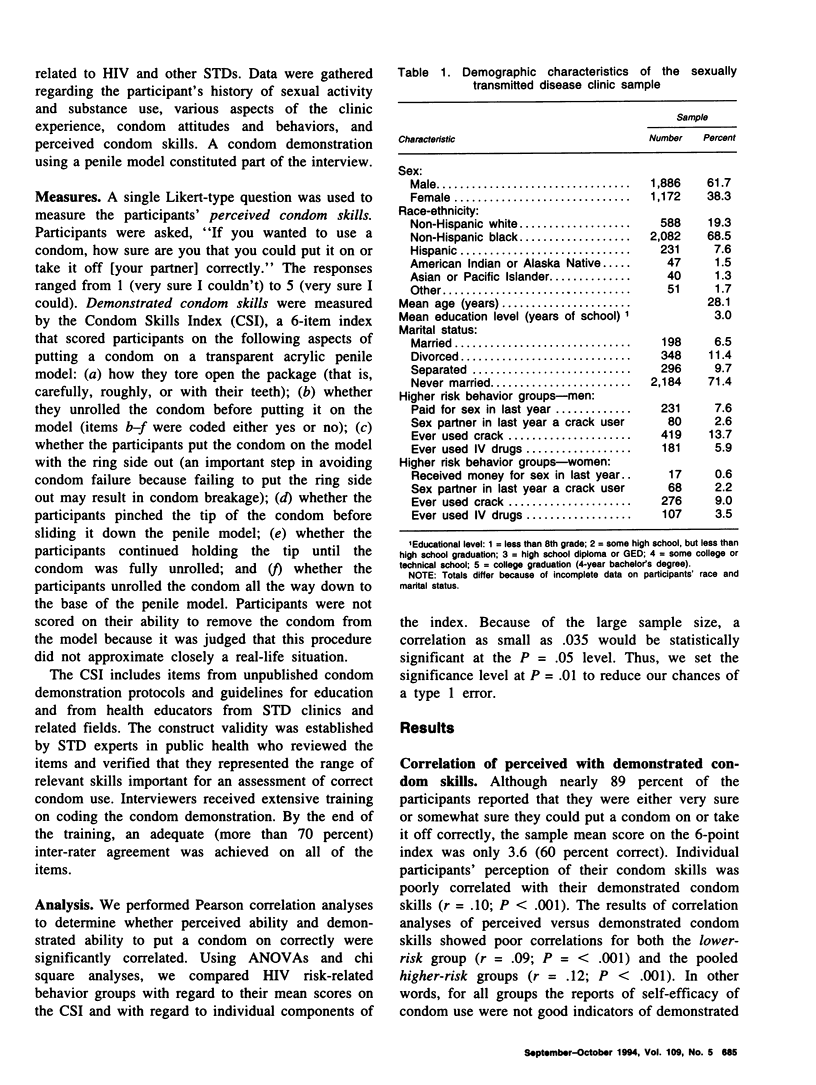
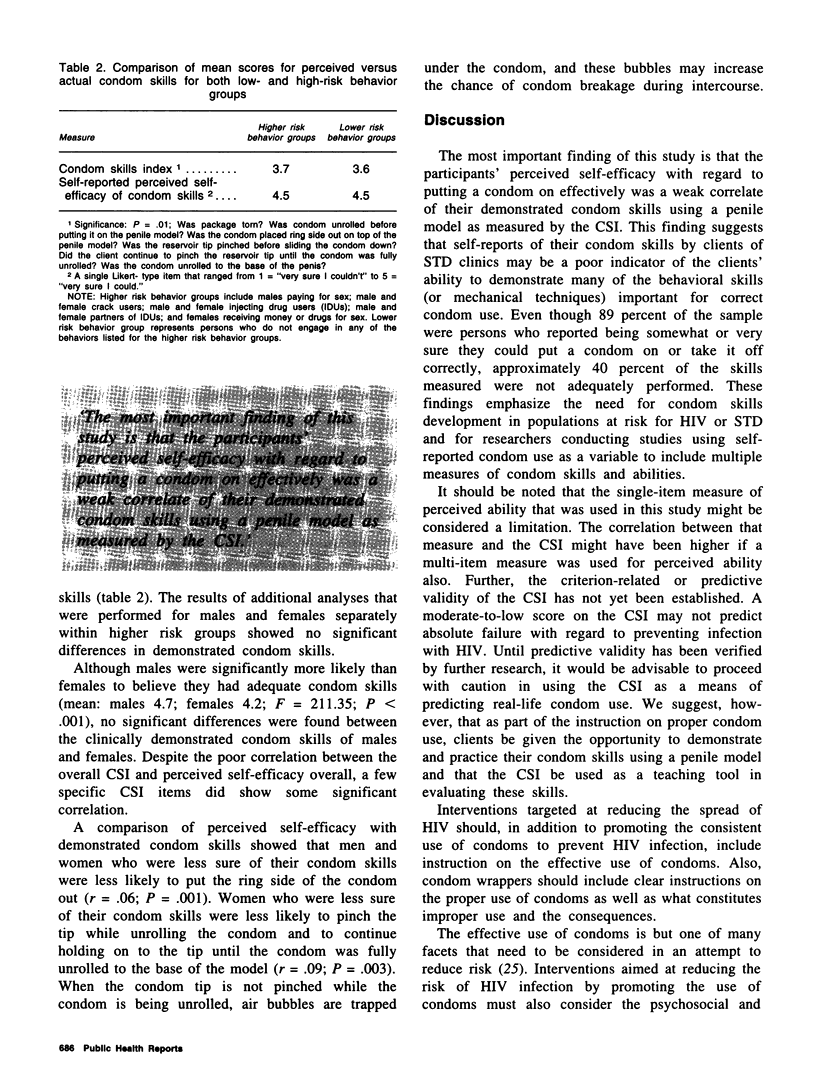
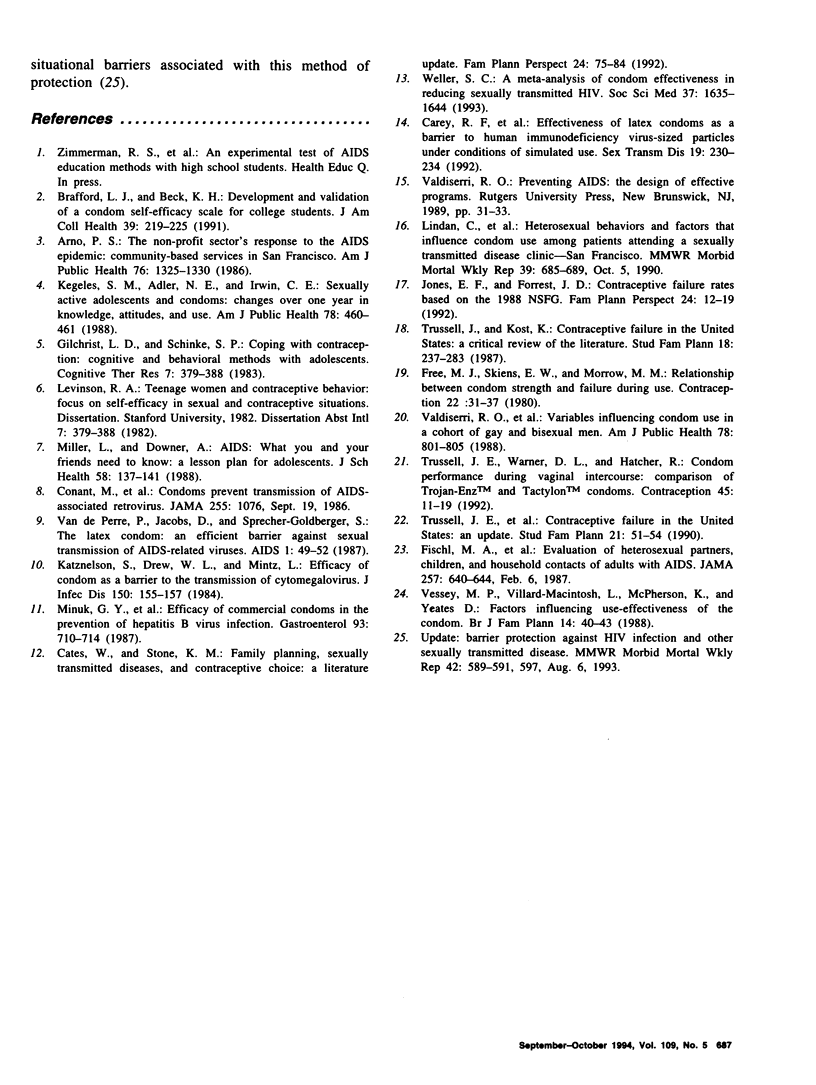
Selected References
These references are in PubMed. This may not be the complete list of references from this article.
- Arno P. S. The nonprofit sector's response to the AIDS epidemic: community-based services in San Francisco. Am J Public Health. 1986 Nov;76(11):1325–1330. doi: 10.2105/ajph.76.11.1325. [DOI] [PMC free article] [PubMed] [Google Scholar]
- Brafford L. J., Beck K. H. Development and validation of a condom self-efficacy scale for college students. J Am Coll Health. 1991 Mar;39(5):219–225. doi: 10.1080/07448481.1991.9936238. [DOI] [PubMed] [Google Scholar]
- Carey R. F., Herman W. A., Retta S. M., Rinaldi J. E., Herman B. A., Athey T. W. Effectiveness of latex condoms as a barrier to human immunodeficiency virus-sized particles under conditions of simulated use. Sex Transm Dis. 1992 Jul-Aug;19(4):230–234. doi: 10.1097/00007435-199207000-00009. [DOI] [PubMed] [Google Scholar]
- Cates W., Jr, Stone K. M. Family planning, sexually transmitted diseases and contraceptive choice: a literature update--Part I. Fam Plann Perspect. 1992 Mar-Apr;24(2):75–84. [PubMed] [Google Scholar]
- Fischl M. A., Dickinson G. M., Scott G. B., Klimas N., Fletcher M. A., Parks W. Evaluation of heterosexual partners, children, and household contacts of adults with AIDS. JAMA. 1987 Feb 6;257(5):640–644. [PubMed] [Google Scholar]
- Free M. J., Skiens E. W., Morrow M. M. Relationship between condom strength and failure during use. Contraception. 1980 Jul;22(1):31–37. doi: 10.1016/0010-7824(80)90115-8. [DOI] [PubMed] [Google Scholar]
- Gilchrist L. D., Schinke S. P. Coping with contraception: cognitive and behavioral methods with adolescents. Cognit Ther Res. 1983;7(5):379–388. doi: 10.1007/BF01187166. [DOI] [PubMed] [Google Scholar]
- Jones E. F., Forrest J. D. Contraceptive failure rates based on the 1988 NSFG. Fam Plann Perspect. 1992 Jan-Feb;24(1):12–19. [PubMed] [Google Scholar]
- Katznelson S., Drew W. L., Mintz L. Efficacy of the condom as a barrier to the transmission of cytomegalovirus. J Infect Dis. 1984 Jul;150(1):155–157. doi: 10.1093/infdis/150.1.155. [DOI] [PubMed] [Google Scholar]
- Kegeles S. M., Adler N. E., Irwin C. E., Jr Sexually active adolescents and condoms: changes over one year in knowledge, attitudes and use. Am J Public Health. 1988 Apr;78(4):460–461. doi: 10.2105/ajph.78.4.460. [DOI] [PMC free article] [PubMed] [Google Scholar]
- Miller L., Downer A. AIDS: what you and your friends need to know--a lesson plan for adolescents. J Sch Health. 1988 Apr;58(4):137–141. doi: 10.1111/j.1746-1561.1988.tb00546.x. [DOI] [PubMed] [Google Scholar]
- Minuk G. Y., Bohme C. E., Bowen T. J., Hoar D. I., Cassol S., Gill M. J., Clarke H. C. Efficacy of commercial condoms in the prevention of hepatitis B virus infection. Gastroenterology. 1987 Oct;93(4):710–714. doi: 10.1016/0016-5085(87)90431-8. [DOI] [PubMed] [Google Scholar]
- Trussell J., Hatcher R. A., Cates W., Jr, Stewart F. H., Kost K. Contraceptive failure in the United States: an update. Stud Fam Plann. 1990 Jan-Feb;21(1):51–54. [PubMed] [Google Scholar]
- Trussell J., Kost K. Contraceptive failure in the United States: a critical review of the literature. Stud Fam Plann. 1987 Sep-Oct;18(5):237–283. [PubMed] [Google Scholar]
- Trussell J., Warner D. L., Hatcher R. Condom performance during vaginal intercourse: comparison of Trojan-Enz and Tactylon condoms. Contraception. 1992 Jan;45(1):11–19. doi: 10.1016/0010-7824(92)90137-i. [DOI] [PubMed] [Google Scholar]
- Valdiserri R. O., Lyter D., Leviton L. C., Callahan C. M., Kingsley L. A., Rinaldo C. R. Variables influencing condom use in a cohort of gay and bisexual men. Am J Public Health. 1988 Jul;78(7):801–805. doi: 10.2105/ajph.78.7.801. [DOI] [PMC free article] [PubMed] [Google Scholar]
- Van de Perre P., Jacobs D., Sprecher-Goldberger S. The latex condom, an efficient barrier against sexual transmission of AIDS-related viruses. AIDS. 1987 May;1(1):49–52. [PubMed] [Google Scholar]
- Weller S. C. A meta-analysis of condom effectiveness in reducing sexually transmitted HIV. Soc Sci Med. 1993 Jun;36(12):1635–1644. doi: 10.1016/0277-9536(93)90352-5. [DOI] [PubMed] [Google Scholar]


